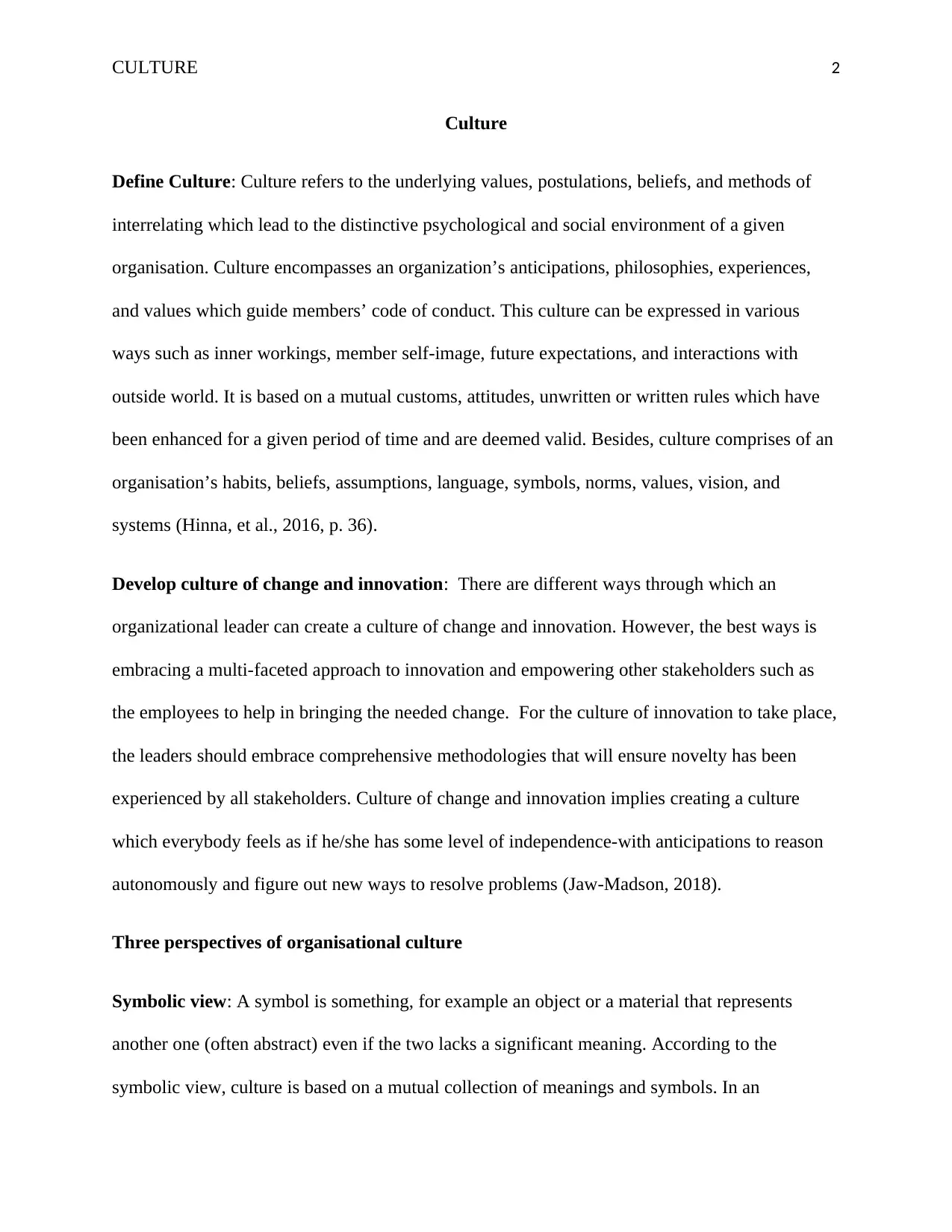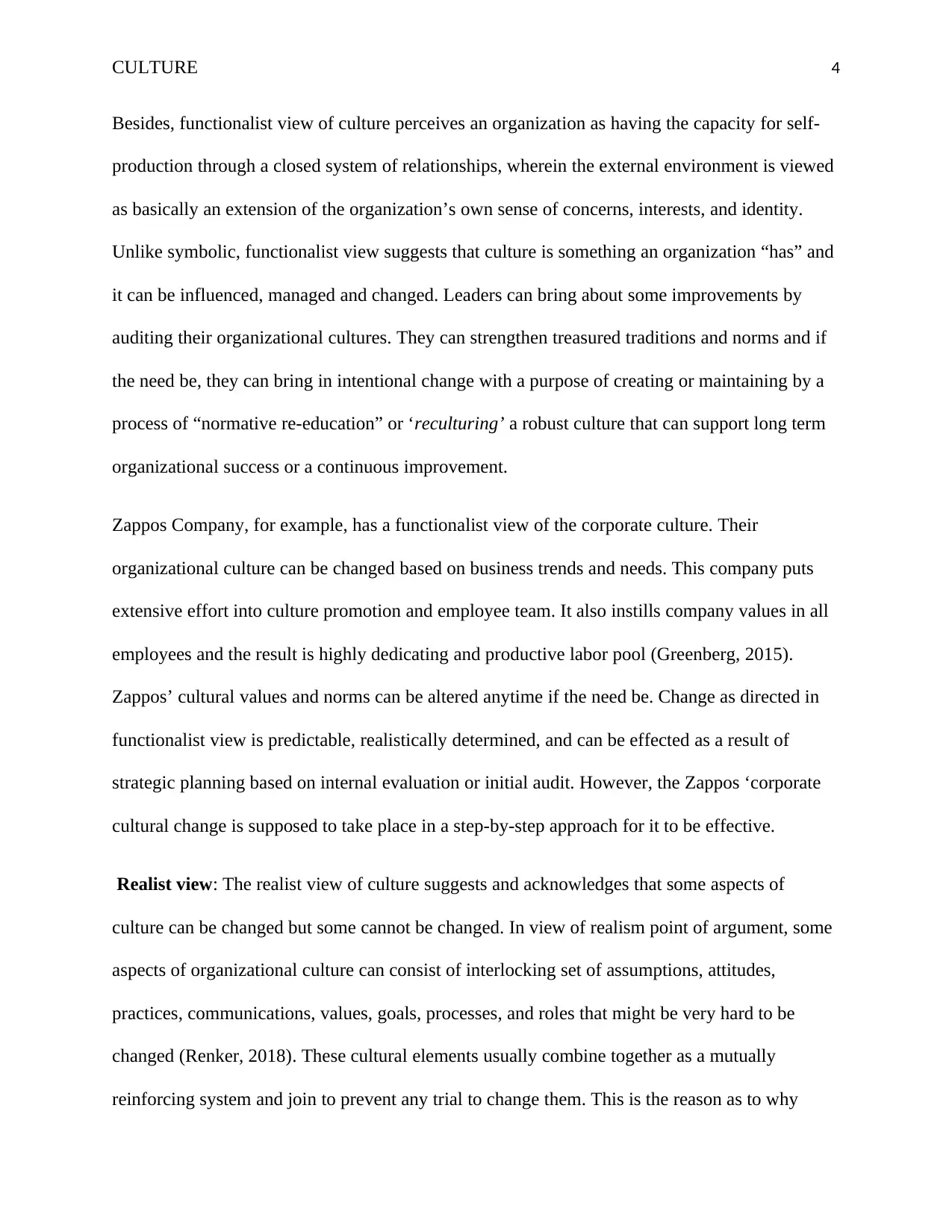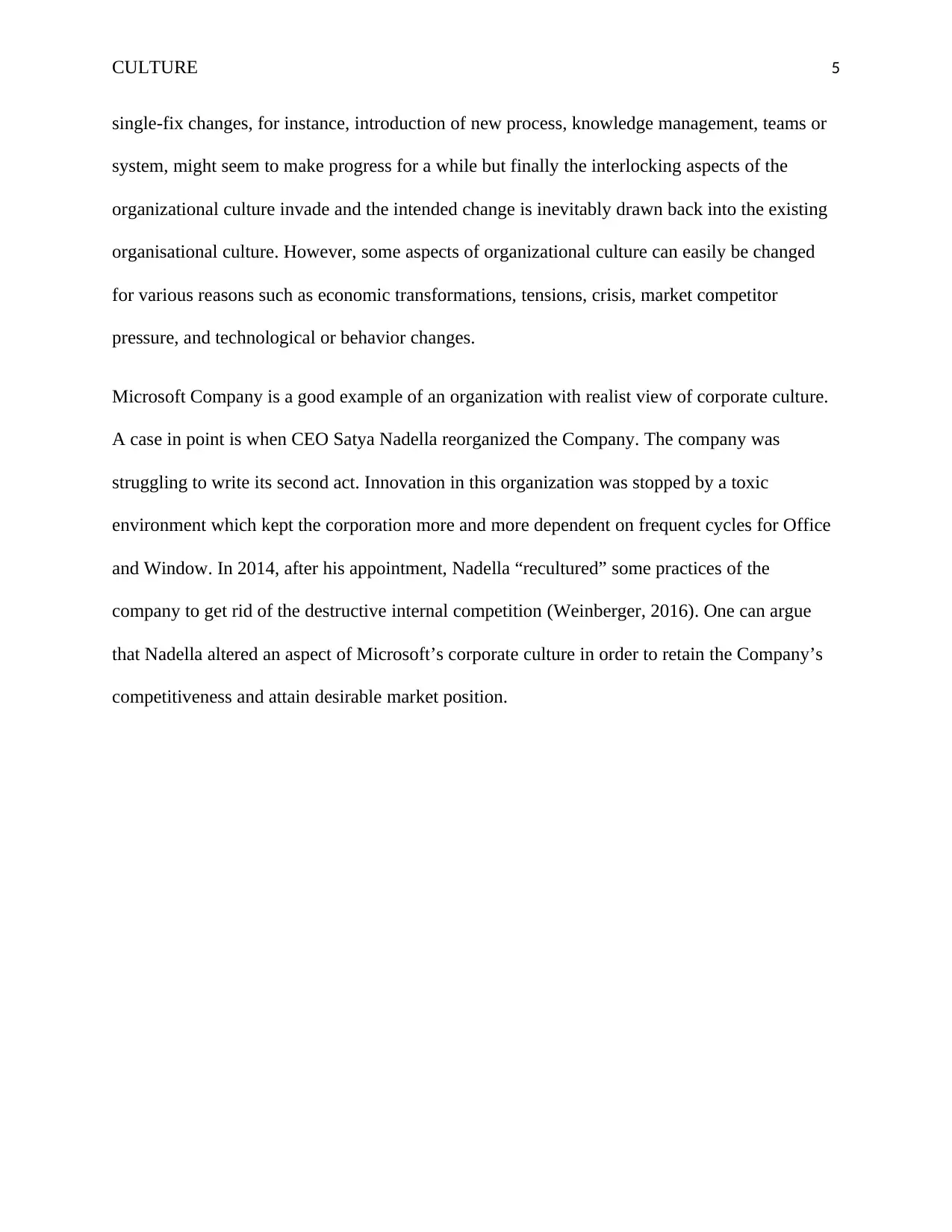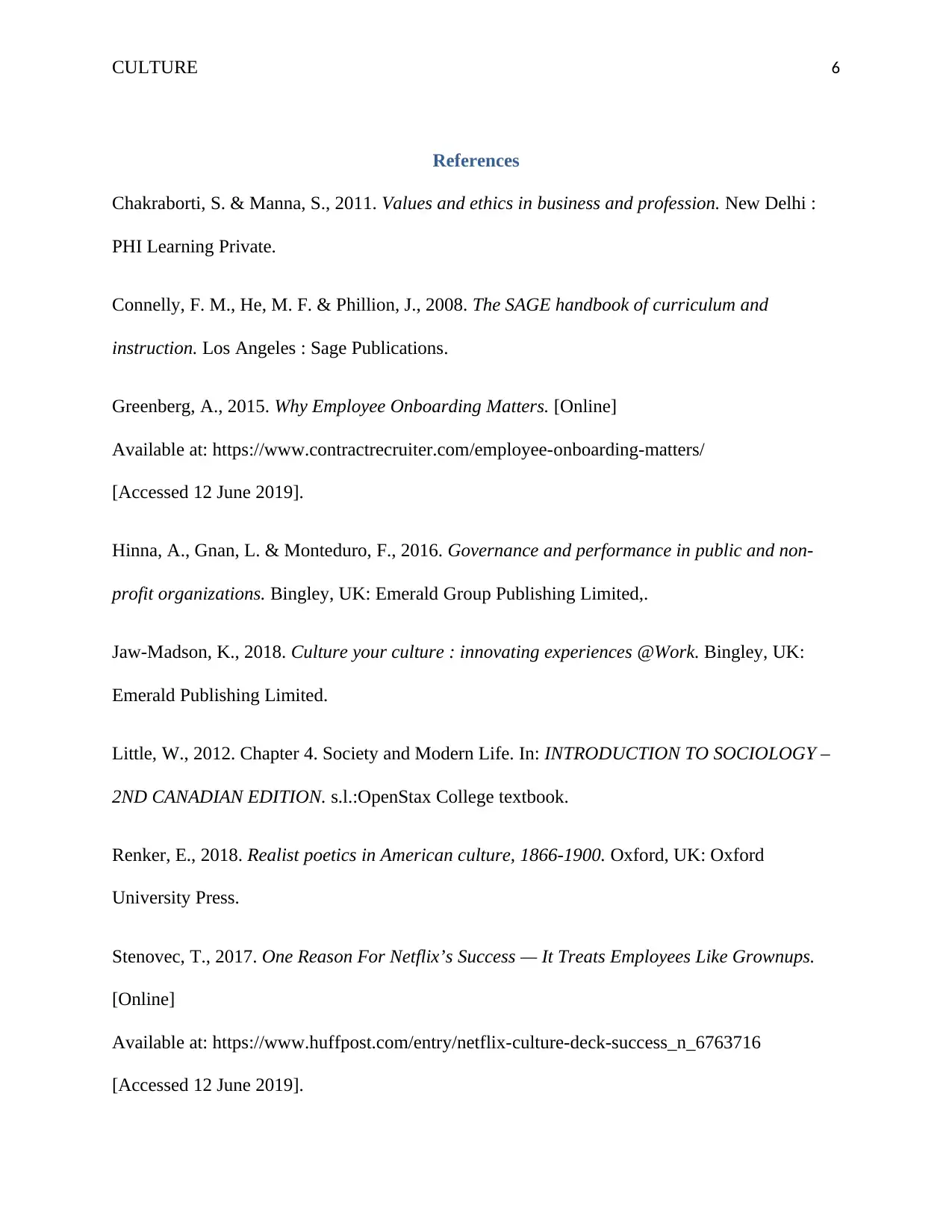Organisational Culture: Defining Culture and its Perspectives
VerifiedAdded on 2022/12/29
|7
|1560
|30
Report
AI Summary
This report provides a comprehensive analysis of organizational culture, beginning with a definition of culture as the underlying values, beliefs, and methods that shape an organization's environment. It then explores strategies for developing a culture of change and innovation, emphasizing the importance of empowering stakeholders. The report delves into three key perspectives of organizational culture: the symbolic view, which emphasizes shared meanings and symbols; the functionalist view, which sees culture as a unifying force; and the realist view, which acknowledges the challenges in changing certain aspects of culture. Each perspective is illustrated with examples from companies like Netflix (symbolic), Zappos (functionalist), and Microsoft (realist), offering insights into how these organizations approach and manage their corporate cultures. The report concludes by highlighting the dynamic nature of culture and its impact on organizational success.

Running head: CULTURE
1
Culture
Institution
Student
Date
1
Culture
Institution
Student
Date
Paraphrase This Document
Need a fresh take? Get an instant paraphrase of this document with our AI Paraphraser

CULTURE 2
Culture
Define Culture: Culture refers to the underlying values, postulations, beliefs, and methods of
interrelating which lead to the distinctive psychological and social environment of a given
organisation. Culture encompasses an organization’s anticipations, philosophies, experiences,
and values which guide members’ code of conduct. This culture can be expressed in various
ways such as inner workings, member self-image, future expectations, and interactions with
outside world. It is based on a mutual customs, attitudes, unwritten or written rules which have
been enhanced for a given period of time and are deemed valid. Besides, culture comprises of an
organisation’s habits, beliefs, assumptions, language, symbols, norms, values, vision, and
systems (Hinna, et al., 2016, p. 36).
Develop culture of change and innovation: There are different ways through which an
organizational leader can create a culture of change and innovation. However, the best ways is
embracing a multi-faceted approach to innovation and empowering other stakeholders such as
the employees to help in bringing the needed change. For the culture of innovation to take place,
the leaders should embrace comprehensive methodologies that will ensure novelty has been
experienced by all stakeholders. Culture of change and innovation implies creating a culture
which everybody feels as if he/she has some level of independence-with anticipations to reason
autonomously and figure out new ways to resolve problems (Jaw-Madson, 2018).
Three perspectives of organisational culture
Symbolic view: A symbol is something, for example an object or a material that represents
another one (often abstract) even if the two lacks a significant meaning. According to the
symbolic view, culture is based on a mutual collection of meanings and symbols. In an
Culture
Define Culture: Culture refers to the underlying values, postulations, beliefs, and methods of
interrelating which lead to the distinctive psychological and social environment of a given
organisation. Culture encompasses an organization’s anticipations, philosophies, experiences,
and values which guide members’ code of conduct. This culture can be expressed in various
ways such as inner workings, member self-image, future expectations, and interactions with
outside world. It is based on a mutual customs, attitudes, unwritten or written rules which have
been enhanced for a given period of time and are deemed valid. Besides, culture comprises of an
organisation’s habits, beliefs, assumptions, language, symbols, norms, values, vision, and
systems (Hinna, et al., 2016, p. 36).
Develop culture of change and innovation: There are different ways through which an
organizational leader can create a culture of change and innovation. However, the best ways is
embracing a multi-faceted approach to innovation and empowering other stakeholders such as
the employees to help in bringing the needed change. For the culture of innovation to take place,
the leaders should embrace comprehensive methodologies that will ensure novelty has been
experienced by all stakeholders. Culture of change and innovation implies creating a culture
which everybody feels as if he/she has some level of independence-with anticipations to reason
autonomously and figure out new ways to resolve problems (Jaw-Madson, 2018).
Three perspectives of organisational culture
Symbolic view: A symbol is something, for example an object or a material that represents
another one (often abstract) even if the two lacks a significant meaning. According to the
symbolic view, culture is based on a mutual collection of meanings and symbols. In an

CULTURE 3
organizational setting, symbolic culture enables people to communicate and must be taught. It
must be taught to every person who joins the organization. Culture is symbolically coded and is
taught from one person to another and therefore it cannot be altered. It is the very personality of
the organisation and cannot be manipulated and changed by anybody. In regards to this view,
culture is dynamic and everybody in a given organization can be taught and all members are
expected to adapt to it. Key elements of symbolic culture are norms, beliefs, values, and
language (Chakraborti & Manna, 2011, p. 8).
Netflix Company has a symbolic approach to corporate culture that it uses to build the company
brand. Physical symbols include awards and name tags that are used to build Netflix’s identity.
Physical symbols such as offices with labels, marketing parking spaces, and name tags all serve
the Company’s corporate culture and vital symbols in the workplace. In most cases, Netflix uses
these symbols to indentify persons and their positions. No individual in Netflix, including the
executives has any right or mandate to alter these symbols. They represent the very personality
of Netflix and they cannot be tempered with or manipulated for any reason whatsoever. Anybody
who joins the organization is assumed to be comfortable with its values and therefore, he/she
should strongly resist attempts to disturb them.
Functionalist view: According to the functionalist view, culture is the ‘glue’ that binds an
organization together by a common sense of purpose, values, interdependency, and agreed norms
drawn from both shared broader societal values (Little, 2012). This culture is deep rooted in the
tradition and history of the organisation itself. Functionalist view emphasizes consensus and
unity and therefore, culture has ‘problem solving’ and ‘reality-defining’ functions inherited from
the past (Connelly, et al., 2008, p. 250). As a result, organizational culture is viewed as
fundamentally homogenous and holistic, influencing and pervading the whole organization.
organizational setting, symbolic culture enables people to communicate and must be taught. It
must be taught to every person who joins the organization. Culture is symbolically coded and is
taught from one person to another and therefore it cannot be altered. It is the very personality of
the organisation and cannot be manipulated and changed by anybody. In regards to this view,
culture is dynamic and everybody in a given organization can be taught and all members are
expected to adapt to it. Key elements of symbolic culture are norms, beliefs, values, and
language (Chakraborti & Manna, 2011, p. 8).
Netflix Company has a symbolic approach to corporate culture that it uses to build the company
brand. Physical symbols include awards and name tags that are used to build Netflix’s identity.
Physical symbols such as offices with labels, marketing parking spaces, and name tags all serve
the Company’s corporate culture and vital symbols in the workplace. In most cases, Netflix uses
these symbols to indentify persons and their positions. No individual in Netflix, including the
executives has any right or mandate to alter these symbols. They represent the very personality
of Netflix and they cannot be tempered with or manipulated for any reason whatsoever. Anybody
who joins the organization is assumed to be comfortable with its values and therefore, he/she
should strongly resist attempts to disturb them.
Functionalist view: According to the functionalist view, culture is the ‘glue’ that binds an
organization together by a common sense of purpose, values, interdependency, and agreed norms
drawn from both shared broader societal values (Little, 2012). This culture is deep rooted in the
tradition and history of the organisation itself. Functionalist view emphasizes consensus and
unity and therefore, culture has ‘problem solving’ and ‘reality-defining’ functions inherited from
the past (Connelly, et al., 2008, p. 250). As a result, organizational culture is viewed as
fundamentally homogenous and holistic, influencing and pervading the whole organization.
⊘ This is a preview!⊘
Do you want full access?
Subscribe today to unlock all pages.

Trusted by 1+ million students worldwide

CULTURE 4
Besides, functionalist view of culture perceives an organization as having the capacity for self-
production through a closed system of relationships, wherein the external environment is viewed
as basically an extension of the organization’s own sense of concerns, interests, and identity.
Unlike symbolic, functionalist view suggests that culture is something an organization “has” and
it can be influenced, managed and changed. Leaders can bring about some improvements by
auditing their organizational cultures. They can strengthen treasured traditions and norms and if
the need be, they can bring in intentional change with a purpose of creating or maintaining by a
process of “normative re-education” or ‘reculturing’ a robust culture that can support long term
organizational success or a continuous improvement.
Zappos Company, for example, has a functionalist view of the corporate culture. Their
organizational culture can be changed based on business trends and needs. This company puts
extensive effort into culture promotion and employee team. It also instills company values in all
employees and the result is highly dedicating and productive labor pool (Greenberg, 2015).
Zappos’ cultural values and norms can be altered anytime if the need be. Change as directed in
functionalist view is predictable, realistically determined, and can be effected as a result of
strategic planning based on internal evaluation or initial audit. However, the Zappos ‘corporate
cultural change is supposed to take place in a step-by-step approach for it to be effective.
Realist view: The realist view of culture suggests and acknowledges that some aspects of
culture can be changed but some cannot be changed. In view of realism point of argument, some
aspects of organizational culture can consist of interlocking set of assumptions, attitudes,
practices, communications, values, goals, processes, and roles that might be very hard to be
changed (Renker, 2018). These cultural elements usually combine together as a mutually
reinforcing system and join to prevent any trial to change them. This is the reason as to why
Besides, functionalist view of culture perceives an organization as having the capacity for self-
production through a closed system of relationships, wherein the external environment is viewed
as basically an extension of the organization’s own sense of concerns, interests, and identity.
Unlike symbolic, functionalist view suggests that culture is something an organization “has” and
it can be influenced, managed and changed. Leaders can bring about some improvements by
auditing their organizational cultures. They can strengthen treasured traditions and norms and if
the need be, they can bring in intentional change with a purpose of creating or maintaining by a
process of “normative re-education” or ‘reculturing’ a robust culture that can support long term
organizational success or a continuous improvement.
Zappos Company, for example, has a functionalist view of the corporate culture. Their
organizational culture can be changed based on business trends and needs. This company puts
extensive effort into culture promotion and employee team. It also instills company values in all
employees and the result is highly dedicating and productive labor pool (Greenberg, 2015).
Zappos’ cultural values and norms can be altered anytime if the need be. Change as directed in
functionalist view is predictable, realistically determined, and can be effected as a result of
strategic planning based on internal evaluation or initial audit. However, the Zappos ‘corporate
cultural change is supposed to take place in a step-by-step approach for it to be effective.
Realist view: The realist view of culture suggests and acknowledges that some aspects of
culture can be changed but some cannot be changed. In view of realism point of argument, some
aspects of organizational culture can consist of interlocking set of assumptions, attitudes,
practices, communications, values, goals, processes, and roles that might be very hard to be
changed (Renker, 2018). These cultural elements usually combine together as a mutually
reinforcing system and join to prevent any trial to change them. This is the reason as to why
Paraphrase This Document
Need a fresh take? Get an instant paraphrase of this document with our AI Paraphraser

CULTURE 5
single-fix changes, for instance, introduction of new process, knowledge management, teams or
system, might seem to make progress for a while but finally the interlocking aspects of the
organizational culture invade and the intended change is inevitably drawn back into the existing
organisational culture. However, some aspects of organizational culture can easily be changed
for various reasons such as economic transformations, tensions, crisis, market competitor
pressure, and technological or behavior changes.
Microsoft Company is a good example of an organization with realist view of corporate culture.
A case in point is when CEO Satya Nadella reorganized the Company. The company was
struggling to write its second act. Innovation in this organization was stopped by a toxic
environment which kept the corporation more and more dependent on frequent cycles for Office
and Window. In 2014, after his appointment, Nadella “recultured” some practices of the
company to get rid of the destructive internal competition (Weinberger, 2016). One can argue
that Nadella altered an aspect of Microsoft’s corporate culture in order to retain the Company’s
competitiveness and attain desirable market position.
single-fix changes, for instance, introduction of new process, knowledge management, teams or
system, might seem to make progress for a while but finally the interlocking aspects of the
organizational culture invade and the intended change is inevitably drawn back into the existing
organisational culture. However, some aspects of organizational culture can easily be changed
for various reasons such as economic transformations, tensions, crisis, market competitor
pressure, and technological or behavior changes.
Microsoft Company is a good example of an organization with realist view of corporate culture.
A case in point is when CEO Satya Nadella reorganized the Company. The company was
struggling to write its second act. Innovation in this organization was stopped by a toxic
environment which kept the corporation more and more dependent on frequent cycles for Office
and Window. In 2014, after his appointment, Nadella “recultured” some practices of the
company to get rid of the destructive internal competition (Weinberger, 2016). One can argue
that Nadella altered an aspect of Microsoft’s corporate culture in order to retain the Company’s
competitiveness and attain desirable market position.

CULTURE 6
References
Chakraborti, S. & Manna, S., 2011. Values and ethics in business and profession. New Delhi :
PHI Learning Private.
Connelly, F. M., He, M. F. & Phillion, J., 2008. The SAGE handbook of curriculum and
instruction. Los Angeles : Sage Publications.
Greenberg, A., 2015. Why Employee Onboarding Matters. [Online]
Available at: https://www.contractrecruiter.com/employee-onboarding-matters/
[Accessed 12 June 2019].
Hinna, A., Gnan, L. & Monteduro, F., 2016. Governance and performance in public and non-
profit organizations. Bingley, UK: Emerald Group Publishing Limited,.
Jaw-Madson, K., 2018. Culture your culture : innovating experiences @Work. Bingley, UK:
Emerald Publishing Limited.
Little, W., 2012. Chapter 4. Society and Modern Life. In: INTRODUCTION TO SOCIOLOGY –
2ND CANADIAN EDITION. s.l.:OpenStax College textbook.
Renker, E., 2018. Realist poetics in American culture, 1866-1900. Oxford, UK: Oxford
University Press.
Stenovec, T., 2017. One Reason For Netflix’s Success — It Treats Employees Like Grownups.
[Online]
Available at: https://www.huffpost.com/entry/netflix-culture-deck-success_n_6763716
[Accessed 12 June 2019].
References
Chakraborti, S. & Manna, S., 2011. Values and ethics in business and profession. New Delhi :
PHI Learning Private.
Connelly, F. M., He, M. F. & Phillion, J., 2008. The SAGE handbook of curriculum and
instruction. Los Angeles : Sage Publications.
Greenberg, A., 2015. Why Employee Onboarding Matters. [Online]
Available at: https://www.contractrecruiter.com/employee-onboarding-matters/
[Accessed 12 June 2019].
Hinna, A., Gnan, L. & Monteduro, F., 2016. Governance and performance in public and non-
profit organizations. Bingley, UK: Emerald Group Publishing Limited,.
Jaw-Madson, K., 2018. Culture your culture : innovating experiences @Work. Bingley, UK:
Emerald Publishing Limited.
Little, W., 2012. Chapter 4. Society and Modern Life. In: INTRODUCTION TO SOCIOLOGY –
2ND CANADIAN EDITION. s.l.:OpenStax College textbook.
Renker, E., 2018. Realist poetics in American culture, 1866-1900. Oxford, UK: Oxford
University Press.
Stenovec, T., 2017. One Reason For Netflix’s Success — It Treats Employees Like Grownups.
[Online]
Available at: https://www.huffpost.com/entry/netflix-culture-deck-success_n_6763716
[Accessed 12 June 2019].
⊘ This is a preview!⊘
Do you want full access?
Subscribe today to unlock all pages.

Trusted by 1+ million students worldwide

CULTURE 7
Weinberger, M., 2016. How Microsoft CEO Satya Nadella did what Steve Ballmer and Bill
Gates couldn’t. [Online]
Available at: https://www.businessinsider.com/satya-nadella-achieved-one-microsoft-vision-
2016-1?IR=T
[Accessed 12 June 2019].
Weinberger, M., 2016. How Microsoft CEO Satya Nadella did what Steve Ballmer and Bill
Gates couldn’t. [Online]
Available at: https://www.businessinsider.com/satya-nadella-achieved-one-microsoft-vision-
2016-1?IR=T
[Accessed 12 June 2019].
1 out of 7
Your All-in-One AI-Powered Toolkit for Academic Success.
+13062052269
info@desklib.com
Available 24*7 on WhatsApp / Email
![[object Object]](/_next/static/media/star-bottom.7253800d.svg)
Unlock your academic potential
Copyright © 2020–2026 A2Z Services. All Rights Reserved. Developed and managed by ZUCOL.
